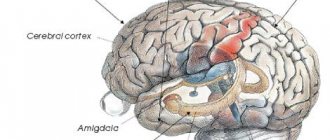Researchers from the University of Bristol studied the reaction of rats to tickling. They found a way to accurately measure the emotions of rodents and noticed that some of them squeaked during this procedure. Tests have shown that the pitch of the squeak is directly proportional to the level of pleasure the rat experiences when tickled. This once again proves that tickling is an ancient mechanism inherited by humans from distant ancestors.
Our body constantly “talks” to us in the language of signals. We'll tell you why evolution came up with some physiological mechanisms and what meaning it put into them.
Tickling
There are different versions of why nature has endowed us with the ability to laugh when tickled, as well as to be afraid of it. One hypothesis is that it signaled to our ancestors about insects crawling on the skin that could be parasites. Hence the fear of tickling, familiar to many of us.
But then it is not clear why tickling causes laughter. Is this a normal reaction to insects crawling on your body? Therefore, other scientists adhere to a different version: tickling is needed to establish contact between the cub and its mother. With its help, without having absolutely anything at hand (or paw), they can play, have fun and get positive emotions. This version is also supported by the fact that with age we stop responding to tickling with laughter. On the contrary, many people find it unpleasant.
It's ticklish! What makes you laugh? More details
There is an opinion that in previous centuries tickling was used as torture and could bring a person to death. “Most likely, these are fictions and horror stories,” says physiologist, candidate of medical sciences Nikolai Zakharov . “You can’t tickle a person to death.” The body adapts to the tickling: you either stop feeling it or temporarily lose consciousness.”
How does this happen
Yes, just like almost any other reflex! The nerve endings are stimulated and send an impulse to the brain, which makes us laugh. However, not everything is so simple, because this process simultaneously involves the part of the brain that determines whether this sensation is pleasant for the brain or not, and the area in the hypothalamus, where the automatic reaction to the threat comes from. It turns out in two ways, but at least it’s clear why we are afraid of tickling on a reflex level. But what causes the brain to react this way?
Goosebumps
They cover us from the cold. But it happens that their appearance is caused by some event colored by strong emotions - someone’s action, a movie seen, music listened to...
This mechanism, which in the language of science is called piloerection, and in common parlance - “goose bumps”, also came to us from primitive people, and to them from their mammalian ancestors. Goose bumps on the surface of the body are caused by the contraction of tiny muscles in the skin. They raise the hair when freezing so that the heated air lingers longer near the body and does not fly away into the surrounding space.
"Goose pimples". Why do goosebumps appear and run all over your body? Read more
The same reflex is triggered in a situation of danger: raised hair makes the animal (look at a cat when it meets a dog) more massive, giving it a frightening appearance. With strong emotional reactions - rage, fear, delight - our nervous system is excited, and this can lead to goosebumps. If we had wool, it would stand on end at that moment.
Piloerection has lost its practical meaning for humans, turning into a rudiment, like some organs of our body - the coccyx, the appendix. After all, Homo sapiens long ago lost their thick coat of fur, and invented clothing to protect them from the cold.
Tickling development2
Tikling itself has no clear location in the world, there are no inventors and no history. Tikling has always existed and is widespread throughout the planet. Even animals are susceptible to it: monkeys and rats are big fans of tickling each other. But nevertheless, the beginning of this direction was involuntarily laid in the USA. There, in the 90s of the last century, one cheerful American passionately tickled a naked beauty, filming it all on video. The video went on sale marked “XXX” and quickly found its followers.
In 2001, when Russia opened its first porn site, tikling entered the country, where “there is no sex.” Then the first communities of ticklers began to appear, which are now actively communicating with “ticklers” around the world.
The contribution of tickle addicts to the development of tickling is very serious. They developed the technique, the rules, and wrote an entire treatise on “erotic tickling,” authored by Michael Morin.
Shiver
This mechanism is similar to the one that causes goosebumps. When a person is cold or scared, he begins to tremble. Why?
Warm-blooded animals, and we are one of them, have a very important physiological ability - to maintain body temperature at a constant level. Trembling your muscles is one way to avoid heat loss and a drop in temperature when it suddenly gets cold. Skeletal muscles begin to make small and frequent contractions, which release heat that spreads throughout the body.
“The brain runs on one battery.” What our scientists found in the human head Read more
“When a person is scared, he also begins to tremble. This way we strengthen the functioning of the nervous system, including the autonomic one. All organs and internal systems are tuned to actions related to salvation - either an attack on the enemy, or a swift escape,” explains the scientific secretary of the Institute of Physiology. I. P. Pavlova RAS, candidate of biological sciences Alexander Chuikin .
It is noteworthy that muscle contractions are sometimes used by cold-blooded animals: insects, fish, and reptiles. For example, bees and bumblebees warm their hives and nests due to the intensive work of their wings. They do this to prevent the developing larvae from getting cold.
Tickle to orgasm6
Erotic tickling has its own technique. Tikling practitioners even came up with names and descriptions for each tickling method.
- Poke – with several fingers the tickler acts on responsive zones at once. These are the hips
knees, back, stomach and, of course, ribs. The pokes should be gentle, as some areas, such as getting your fingers between the ribs, can cause real pain.
- Scraper - done by alternating movements with the tips of the nails. If the length of the nails
not enough, you can use brushes or combs. The area of influence is the feet, palms, back of the neck and collar area, armpits, palms, elbows.
- Charioteer - performed with a pointed object or long, sharp nails. The movement resembles a track. It is performed starting from the feet and gradually rises up to the stomach or lower back.
- Overdoing is reminiscent of poking. Fingers seem to be running over the body. Movements are fast: up - down. Reminds me of playing an accordion. It is most often used on the ribs, but can be successfully practiced throughout the body.
- Bondage is more related to real BDSM. Deprives the partner of the opportunity to offer the slightest resistance and the possibility of escape. All that remains is to choke with laughter and excitement. Foot tying is especially effective, and simultaneous tickling of both soles produces sensations of electric shock.
All techniques can be performed not only with your hands, but also with your tongue or use various accessories.
Cry
The practical benefits of tears are well known to physiologists and ophthalmologists. They moisten the cornea of our eye and thereby protect it from foreign objects (for example, from an eyelash falling into the eye), as well as from drying out, infections, and caustic volatile substances. And thus improve the quality of vision. For example, if a speck or eyelash gets into the eye, the tears will wash it away.
Cry, girl! What are the benefits of tear therapy? More details
All land animals have lacrimal glands, which constantly produce a fluid of complex composition. By the way, the chemical compositions of blood and tear fluid are close. Roughly speaking, it is a derivative of blood and also contains several types of salts. And the most useful substance found in our tears is lysozyme. It can kill many microbes and provide disinfection of the eye membranes.
However, why do people cry when they have a strong emotional reaction - grief, fear, compassion, as well as great joy? Scientists are still arguing about the reasons. There are two versions here, and perhaps both are correct. Firstly, crying gives a signal to other people that you feel bad and need help or sympathy. Because Homo sapiens are more socially connected than anyone else in the animal kingdom, empathy and compassion are very important from an evolutionary perspective. Neuroscientists conducted an experiment: they asked photographs to determine the degree of sadness of crying people, while in some photographs the tears were removed using Photoshop. People who had tears removed from their faces seemed less sad to the subjects.
The second hypothesis: tears help the crying person cope with emotional stress and alleviate grief. After all, stress hormones leave the body along with them. Therefore, after crying, we feel relieved.
“Male and female are different.” Neuroscientist on the secrets of the human brain Read more
Things to remember
The main rule in tikling is adherence to the principle of BDR - safety, reasonableness, voluntariness. Although tickling won't cause any serious harm to your partner, don't forget that playing for too long can make your tickle go berserk. Skilled subjects often encountered the fact that not everyone likes tickling, and therefore in 2008 a tickling code was created in Russia. Here are its basic principles:
Tikling is not violence. Tickling is a process in which people take part of their own free will and have the right to stop at any time. Tikley is recognized only by those who volunteered for the session of their own free will and without coercion; — tikling should in no case harm the physical or mental health of the tikli. At the same time, it is allowed to play out the situation when the tiklya “dies of laughter” in stories or thematic films.
Hiccups
Our main breathing muscle is called the diaphragm. Hiccups arise from the fact that spasms appear in it and, with sudden contractions, strong convulsive breaths occur. This is the mechanism, but the cause of hiccups is not completely clear.
“One version is a pinched vagus nerve. It passes from the chest to the abdominal cavity, closely adjacent to the esophagus. When we eat hastily, quickly filling the stomach, the vagus nerve is pressed and irritated, says physiologist, candidate of medical sciences Nina Alekseeva. - The same effect is possible if we take a sharp breath from cold or fear. The body reacts quickly to compression of the nerve: it gives a signal to the central nervous system, and it begins to contract the diaphragm in order to free the vagus nerve, on which the functioning of many of our organs depends. That is, hiccups are such a defense mechanism.”
Hiccups may be a legacy of the very ancient ancestors of humanity, who breathed through gills, some scientists believe. They suggest that there are connections left in the ancient cortex of our brain that are responsible for pushing water out of the gills. An analogy has been noted between hiccups and ventilation in tadpoles.
Male hobby
There are far more men than women among tickle addicts: 89% versus 11% of women. The peak of hobby is at 21-25 years old and 31-35 years old. 45% prefer an active role in tickling, 14% prefer a passive role, and 30% of addicts are generalists. An active tickler is usually called a tickler, and a passive one is called a tickler. Usually ticklers are divided into pairs. Sometimes group tikling sessions are also held. Two men “pounce” on one woman, or two fairies tickle the lucky one at once. Tikling
can be either a prelude to intimacy or an independent process that brings ticklers to sexual release. An interesting observation: most ticklers were born under the sign of Gemini.
The smell of sweat
Each of us has encountered a situation when there is a person nearby whose smell of sweat literally makes us sick. Holding our nose, we think: “How can his loved ones tolerate him? Although what kind of loved ones... Who would live with such a stinker? However, it soon turns out that the person has a spouse, and he (she) does not find this smell unpleasant. How so?
The smell of illness. What does the body smell like with this or that pathology? More details
“A lot of glands that secrete sweat are located in the armpit area. The hair growing there enhances the smell of sweat and concentrates it. This smell has an important biological function. Our ancestors used it to find marriage partners. Nature intended it this way: the more different the genotypes of the parents are, the better for their offspring - they will have a more diverse set of genes, explains Nikolai Zakharov. — Scientists have proven that if a person finds someone else’s smell pleasant, it means that its carrier is suitable for him as a sexual partner according to his genotype. But the repulsive smell says otherwise.”
True, there is an opinion that it is not sweat that a person smells, but the microbes that live in abundance on his body. And sweat, which is almost 100% water, only creates good conditions for their reproduction.
Finding fame
It was the Americans who first attracted the attention of the world community to the topic of tikling. In the early nineties, videos about ticklers began to be actively released on wide screens. Of course, no one explicitly and directly spoke about calls for such a method of sexual release. However, everything was already clear. In the video, the man was seen gently tickling a half-naked girl. His protégé burst into laughter and wriggled, and it immediately became clear that tickling was not just pleasant for her, but gave her great pleasure.
An unexpected fact - videos that captured tickling with the aim of pleasing a partner began to be released back in the sixties of the twentieth century. Then television was not so accessible, and it was also more strictly censored. The videos were recorded on cassettes, and then the materials were carefully put on the market, where they were purchased by those who liked tickling not only in the bedroom, but also on the screen.
What did these film masterpieces contain? Naturally, they were equated to pornographic products, because in the plot, experienced porn actresses tickled each other with feathers, hands, nails, and in the end everything was completed using completely traditional methods.
Russia has lagged behind the advanced states by a whole decade. In our country, people started talking about tikling only in 2001, when the very first forum dedicated to this topic appeared on the Internet. It was created by a certain user registered under the nickname Tickler. He began to develop the portal: translated texts from foreign sources, downloaded videos and photo materials from them, then uploaded them to his site.
Those who perfectly understand what we are talking about, as well as simply curious users who want to learn new things through the World Wide Web, began to flock there. As a result, the site began to be filled with materials supplied by domestic activists of the movement.
Fans of BDSM tickling organized the first mass gathering in 2005. A sufficient number of people of different ages and social status gathered on Manezhnaya Square near the monument to Marshal Zhukov.
And a year later there was a split. Some users chose tickler.ru as their main platform. The remaining users switched to the portal shekotka.ru. Today everything has returned to normal again. These two Internet platforms have established mutually beneficial cooperation.
Through the joint efforts of users and site administrations, content is filmed (both video and photos), accessories for an unusual hobby are sold, and part of the forum is actively populated, where people can ask questions, share experiences and post short articles on a topic that interests them in the field of tickling.
Tickler communities from other countries also joined the Russians: Israel, Ukraine, Belarus, Kazakhstan and a number of other countries. Therefore, we can say with certainty that tikling is extremely popular.
In addition, here are some fascinating facts about the love of tikling among other nationalities.
- Africans practice rougher tickling, which is due to the hard life of dark-skinned people. Passion and intemperance - these are precisely the qualities that do not allow them to relax and be gentle.
- Indian wisdom and teachings carried over into tikling. Residents of India tend to play with their partner, changing the rhythm and intensity during tickling.
- Discreet Eastern Europeans - the Chinese, the Japanese - love to use their feet as an object for tikling. They show passion with restraint and just as gently give pleasure to their partner, literally with one touch.
- Arabs are hot guys. In addition, they are not short of ingenuity. It was among the Arab people that the concept of “a thousand fingers” originated. It refers to the process of tickling with hair.
Vulnerabilities
Each person has his own most sensitive place. This is expressed by the characteristics of the human nervous system. Some areas are most vulnerable to tickling:
- Feet;
- ribs;
- stomach;
- popliteal fossa;
- armpits.
In these areas, any contact with the skin can cause convulsive uncontrolled movements, tears through a smile. Tickling is not as harmless as it might seem. Those who want to overcome their fear will have to understand how pronounced the fear is and what symptoms it has.
Vulnerable spots for tickling










